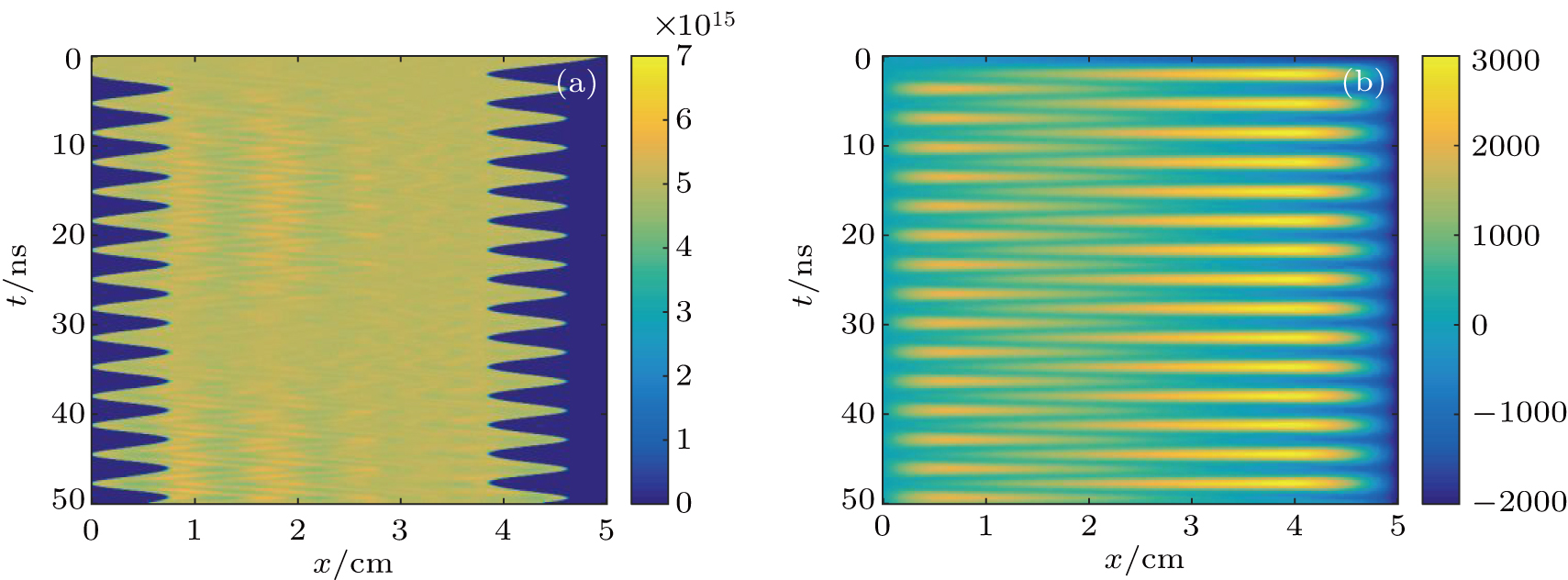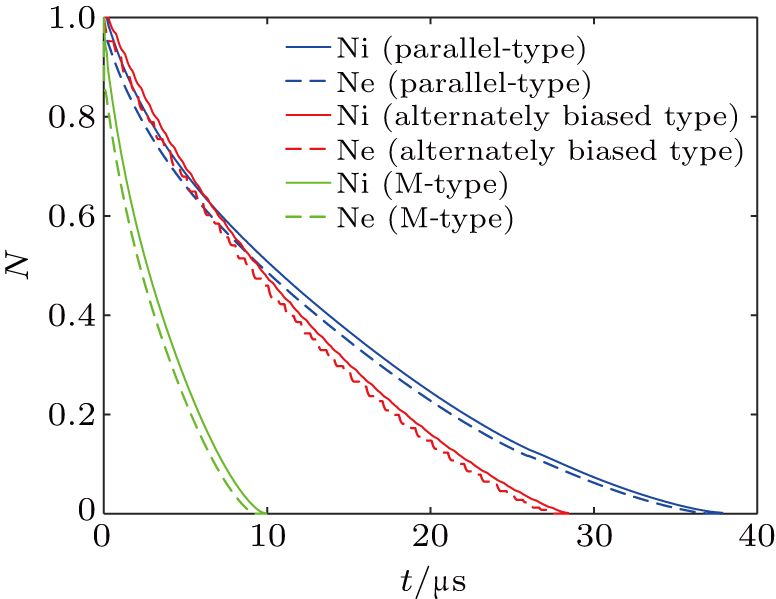† Corresponding author. E-mail:
The processes of electric ion extraction from plasma induced by pulse lasers are simulated by particle-in-cell (PIC) method and hybrid-PIC method. A new calculation scheme named preprocessing hybrid-PIC is presented because neither of the two methods above is omnipotent, especially under the circumstance of high initial plasma density. The new scheme provides credible results with less computational consumption than PIC method in both one- and two-dimensional simulations, except for Π-type electrode configuration. The simulation results show that the M-type performs best in all electrode configurations in both high-density and low-density plasma conditions.
Investigations of ion extraction in laser-induced plasma have been an important researching topic for their applications such as in ion plantation,[1] ion beam generation,[2,3] and nuclear fusion,[4,5] especially the laser isotope separation (LIS) process.[6–8] In the last several decades, an ion extraction method with the characters of short extraction time, simple structure and less influence on other processes was required, especially under the circumstance of high-density plasma (∼1011 cm−3) and big size (several centimeters) for commercial values. Several extraction configurations meeting these requirements were reported. It should be noted that the experimental setups become complex and the ionization is disturbed due to the Zeeman effect if magnetic field is adopted, though it may be conducive to breaking the plasma shielding. Therefore, ion extraction by electric field is a common method in both theoretical and experimental researches.
In the early time, Chen[9] and Okano[10] have analyzed the ion extraction process theoretically and Okano derived a simplified formula that can describe extraction time of one-dimensional parallel plate condition. With the development of experimental and computational technology, Yamada et al. have investigated the extraction properties of several electrode configurations experimentally, such as parallel type, Π-type and alternately biased parallel type.[11–14] Scaling laws between ion-extraction time and applied voltage (0.5 kV–4.0 kV), plasma width (2 cm–9 cm), ion density (2 × 108 cm−3–2 × 1010 cm−3) were formulated. Nishio et al. presented a new conceptual electrode system, designated as ‘M-type electrodes’.[15] Rapid ion extraction is possible in the M-type system compared with that in the parallel type system. In theoretical researches, fluid model and particle model based on particle-in-cell (PIC) are used as common models in plasma simulations.[16,17] However, computing divergences of continuum and momentum equations appear easily at discontinuities and the collision processes cannot be described truly in fluid model. Watanabe and Okano have performed one-dimensional PIC and two-dimensional hybrid-PIC simulation and good agreement with the empirical formula given by Okano previously.[18] Ogura et al. calculated gadolinium ion extraction by the two-dimensional hybrid-PIC method, and the results were consistent with the experimental results.[19] Besides, some improved approaches such as two-region PIC[20] and two-system PIC[21,22] that appeared in recent years, provide new ideas for further simulating the ion extraction.
However, both simulations and experiments above were carried out under the circumstance of the low ion density (107 cm−3–1010 cm−3). The high-density ion extraction (∼ 1011 cm−3), which is required for economic efficiency and production yield in laser isotope purification plants, has been studied rarely. On the one hand, large-scaled metal evaporation and laser devices are required for high-density ion extraction experiments. On the other hand, PIC method occupies a huge computation cost in high-density two- or three-dimensional plasma simulations and the errors accumulate gradually in transient simulations. Besides, the applicability of hybrid-PIC still needs to be verified due to the fact that its electron thermal-equilibrium assumption is made. Therefore, there are few researches of high-density big-sized ion extraction both in experiment and in theory.
In this article, we build PIC and hybrid-PIC codes in both one- and two-dimensional ion extraction simulations. Firstly, the applicability of the two methods are verified in one-dimensional simulations and the process of electric ion extraction is discussed. Then the preprocessing hybrid-PIC is presented to extend the applicability of PIC method. Next, the extraction times of several electrode configurations are presented for comparison between the results obtained in low and high density situations. Finally, some conclusions are drawn from the present study.
The PIC method and hybrid-PIC method in electrostatic model are used for electric ion extraction simulation. The algorithms of the two methods are based on three steps. First, spatial density distributions, ni and ne, are obtained from the positions of particles by particle-in-cell technique. Second, the Poisson equation, as shown in Eq. (




Figure
Both one- and two-dimensional simulation results are presented in this section. Only parallel type and alternately biased parallel type are displayed in one-dimensional simulations.
Five one-dimensional simulation cases are displayed to verify the applicability of PIC and hybrid-PIC method. The simulation parameters are listed in Table
| Table 1. Simulation parameters in one-dimensional simulation cases. . |
Obviously, the electron oscillation stage cannot be recognized in hybrid-PIC method because electronic motions are not taken into consideration. It means that the simulation results from hybrid-PIC method in Case 2 are incorrect because too many electrons are extracted in the first stage in practical processes. Therefore, the hybrid-PIC method is inapplicable to the circumstance that initial plasma is too close to the electrode plates. However, electron oscillates weakly in alternately biased parallel-type ion extraction because the voltage is increased slowly in the first stage. Therefore, two methods obtain almost identical results in Cases 3 and 4 as shown in Fig.
Figure
 | Fig. 5. Plots of (a) remaining ion and (b) remaining electron ratio as a function of extraction time in Case 5. |
| Table 2. Simulation parameters in one-dimensional simulation cases. . |
Based on the simulations and analyses above, we present a new scheme named preprocessing hybrid-PIC to solve the two problems above. The first stage of ion extraction is calculated by the PIC method and the rest two are calculated by the hybrid-PIC method because the electronic distribution satisfies the thermal-equilibrium assumption in the duration. The computational consumption of preprocessing hybrid-PIC is far less than that of the PIC method as the electron oscillation stage lasts only hundreds of nanoseconds. It should be noted that the deviation in the first stage obtained by the PIC method is insignificant due to its short duration, although none of super-particle number and others can meet the requirements of accurate simulation. Besides, the variation of electric field in plasma is selected to be the criterion for the method transformation. Finally, only total number of electrons and electron temperature are needed when hybrid-PIC method begins to be used, while none of the position and velocity of electron, and the plasma potential is taken into consideration. As shown in Fig.
In this subsection, two-dimensional simulations are carried out in four electrode configurations: parallel type, alternately biased parallel type, Π-type, and M-type, whose diagrams are shown in Fig.
 | Fig. 7. Plots of potential at mid-line in Π-type PIC simulation for three different plasma potentials. |
Figure
One- and two-dimensional particle simulations of ion extraction in laser-induced plasma are displayed by the PIC method and hybrid-PIC method. Three typical stages, electron oscillation, potential fall, and sheath exfoliation, are found to exist in electric ion extraction process. It shows that neither of the above two particle methods is perfect in some ion extraction simulation conditions, and the preprocessing hybrid-PIC are presented. Accurate results can be obtained by this new calculation scheme with less computational consumption than by the PIC method in one-dimensional simulations. In two-dimensional conditions, four electrode configurations, i.e., parallel type, alternately biased parallel type, Π-type, and M-type, are calculated under the circumstances of low and high initial plasma densities. The results show that the M-type has the best performance in all four configurations although the extraction time of high-density Π-type condition is unknown.
| [1] | |
| [2] | |
| [3] | |
| [4] | |
| [5] | |
| [6] | |
| [7] | |
| [8] | |
| [9] | |
| [10] | |
| [11] | |
| [12] | |
| [13] | |
| [14] | |
| [15] | |
| [16] | |
| [17] | |
| [18] | |
| [19] | |
| [20] | |
| [21] | |
| [22] |







